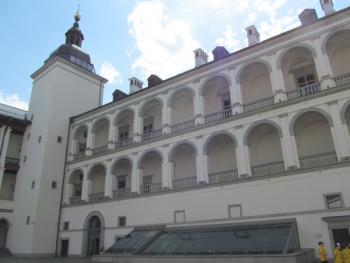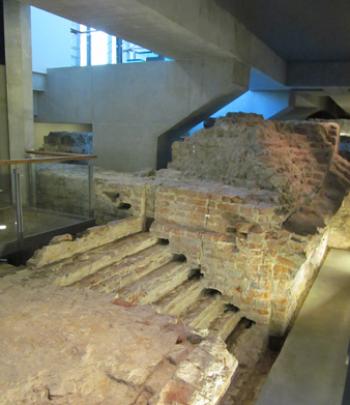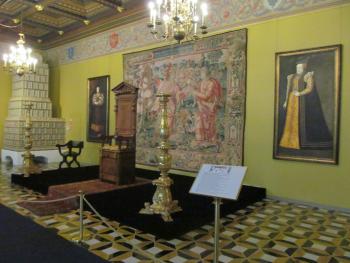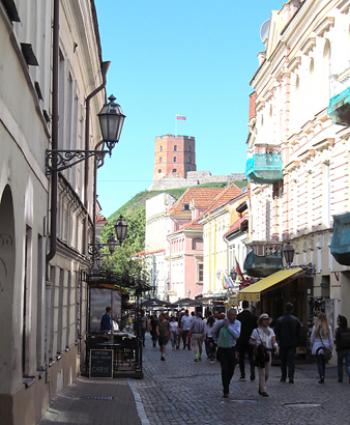Reborn — Palace of the Grand Dukes in Vilnius
This item appears on page 48 of the April 2020 issue.
The story of the Palace of the Grand Dukes in Vilnius, Lithuania, and its rebirth began for me many years ago.
I traveled to Lithuania for the first time in the mid-1970s during the bleak years of the Soviet occupation of the country (1940-41, 1944-90). There was no palace visible then, only a park next to Vilnius’ Cathedral (which the Soviets had turned into an art museum). The park covered the site where a palace had stood for centuries until it was destroyed by the Russians in 1655 and then finally leveled to the ground over the years 1799-1801.
After Lithuania regained its independence in 1990-91, I began to visit frequently with my husband, Paul, because we had decided to sponsor three children in two different families there. We wanted to visit the children and observe their progress over the years, but we also wanted to witness the progress of a Lithuania newly independent from the shackles of Soviet domination.
Part of the nation’s progress involved the rebirth of the ducal palace that had been home, together with its predecessors, to Lithuania’s grand dukes from as early as the late 13th and early 14th centuries. Under one of those rulers, Vytautas the Great (reigned 1392-1430), the territory of the Grand Duchy of Lithuania stretched from the Baltic Sea to the Black Sea and included present-day Belarus as well as portions of what is now Poland, Ukraine and Russia.
Palace reborn
After regaining independence, the Lithuanian Parliament made reconstruction of the Palace of the Grand Dukes of Lithuania a priority. Paul and I were present at all stages of the rebirth, from excavation to construction to symbolic opening of the partially reconstructed palace in 2009, when Lithuania celebrated the 1,000th anniversary of its name’s first appearing in a document, the Annals of Quedlinburg.
Our latest visit was in June 2019. The country’s transformation from what we’d seen on our previous visits was no less than amazing. The restored palace is now almost complete. The exterior with its Renaissance and Baroque architectural features looks the way it probably did in the 16th and 17th centuries. There is a Grand Courtyard with a magnificent open gallery covering one side, with arcades on multiple levels.
Inside the palace museum complex (phone +370 5 212 7476, www.valdovurumai.lt/en), there are now two routes for visitors to follow. One is an archaeological route, the other a tour of the palace’s reconstructed ceremonial halls.
Archaeological tour
The stroll through the palace’s excavated underpinnings is fascinating. It’s a walk through five centuries of history, past fragments of brick wall from the earliest palace of the late 13th century and through cellars dating from the 14th and 15th centuries to when the palace began to be transformed in the 16th century from a defensive structure into a residence fit for a grand duke.
It is estimated that half a million artifacts were found during excavation, many of which are now displayed, including a well-preserved 14th-century wheel, a 14th-century bracelet with an Arabic inscription (perhaps evidence of trade with Arabic countries), a 15th-century icon depicting St. Nicholas, and 16th-century decorated stove tiles.
A highlight of the collection is the 13-foot-wide wood-plank street that probably once led from the palace to adjacent Gediminas Hill.
Palace rooms tour
The second route through the Palace of the Grand Dukes is another walk through history. But here it’s through reconstructed palace rooms displaying enormous tiled stoves, tapestries, paintings, sculpture, maps and furniture spanning the late Gothic, Renaissance, Mannerist (late Renaissance) and Baroque periods, roughly the late 15th to mid-17th centuries.
There are exquisite Flemish tapestries, intricate stone flooring and carved wooden cabinets and wardrobes, but, for me, the highlight was the immense tiled stoves once used to heat vast rooms in winter.
There’s also a Treasury displaying the reconstructed crown of the grand dukes of Lithuania as well as delicate glass goblets and plates.
I could not have imagined in 1977, when I first saw the patch of park at the foot of Gediminas Hill, the riches that would emerge from the ground or the grand palatial structure that would rise above. I can only say “gerai atliktas darbas” (a job well done).
From June to August, the Palace of the Grand Dukes of Lithuania is open from 10 to 6 on Mondays, Tuesdays and Wednesdays, from 10 to 8 on Thursdays, Fridays and Saturdays and from 10 to 4 on Sundays. Check online for the hours for September to May. Admission costs €7 (about $8).
There’s an excellent detailed guidebook in English, “Exposition Guide,” sold in the palace bookshop.
Hilltop castle
On Gediminas Hill, also called Castle Hill, adjacent to the newly restored palace lie the ruins of an even earlier castle called the Upper Castle. A wooden castle may have preceded the brick castle, most probably built by Grand Duke Gediminas (reigned 1316-41) after he made Vilnius his capital in 1323. The Upper Castle was expanded a century later by Vytautas the Great, with defensive walls, towers and a Great Hall added.
Now all that remains are remnants of a defensive wall, castle buildings and one tower, the Gediminas Castle Tower, housing a small museum (phone +370 5 261 7453, www.lnm.lt) with a spectacular view over Vilnius’ Old Town from the viewing platform on top.
To reach the Upper Castle, you can make the steep climb from the park in front of the Palace of the Grand Dukes or take the funicular on Arsenalo Street behind the new Archaeology Museum, also a “must see,” that will zip you uphill in a few minutes.
This is an opportunity to visit both of Vilnius’ castles located side by side: the older Upper Castle and the newly reborn Lower Castle, the Palace of the Grand Dukes of Lithuania.
Gediminas Castle Tower is open daily from 10 to 9. Admission costs €5 ($5.50).
Fairy-tale lake castle
If you’re visiting Vilnius and can make only one excursion outside the city, make it to yet another castle, Trakai, located on Lake Galve˙, 17 miles west of Vilnius.
Begun by Grand Duke Ke˛stutis in the 14th century and completed by his son, Vytautas, it is a picture-perfect castle on a small island in the lake reached by a pedestrian walkway or by a short, 5-minute boat ride. Lithuanian brides and grooms flock there to have their wedding photos taken with the castle as a backdrop.
Paul and I go there on each trip to Lithuania to dine at the atmospheric Apvalaus Stalo Klubas, or Round Table Club (phone +370 699 13 769, asklubas.lt/en.html), beside the lake, with the castle in the background. It’s magical, especially at sunset.
If you go…
On our last four trips to Vilnius we’ve stayed at the Stikliai Hotel (phone +370 5 264 9595, www.stikliai.com), located in the middle of Old Town. If I had to name my favorite hotel in the world of the hundreds I’ve stayed in, this would be it.
A member of the prestigious Relais & Châteaux group, the Stikliai is intimate, atmospheric, elegant and utterly charming. Though boutique-sized, it boasts two restaurants: the high-brow gourmet restaurant offering 5-star dining and the bistro-style Taverna, with tables set outside on the narrow cobblestone street as well as inside.
We like to rent one of the eight apartments that are adjacent to the hotel and which were once the 16th-to-17th-century palace of a Lithuanian noble family. A beautiful flower-and-plant-bedecked courtyard separates the hotel from the apartments. The apartments are understatedly elegant, and no two are alike.
By the way, the word stikliai means “glassblowers” in Lithuanian. In the Middle Ages, this old section of Vilnius used to house all kinds of trades, including glassblowing. (Don’t miss the exquisite door handles on the main entrance to the Stikliai Hotel. The handles are glassblowers in miniature in brass.)
Hotel room rates begin at €142 ($154) per night. Rates for one-bedroom apartments begin at €973 ($1,053) per week.





